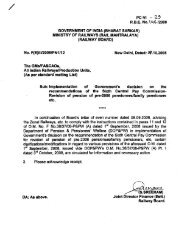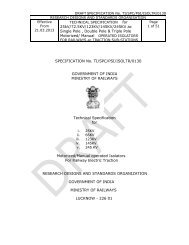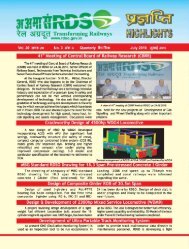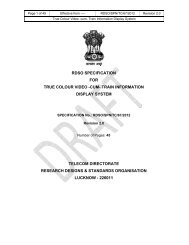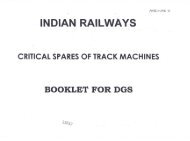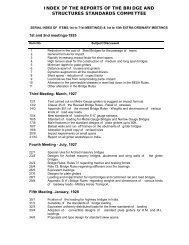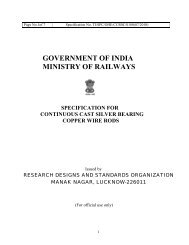TO WHOM SO EVER IT MAY CONCERN - rdso
TO WHOM SO EVER IT MAY CONCERN - rdso
TO WHOM SO EVER IT MAY CONCERN - rdso
Create successful ePaper yourself
Turn your PDF publications into a flip-book with our unique Google optimized e-Paper software.
No. EL / 2.2.1 Date: 5.05.1998<br />
CHIEF ELECTRICAL ENGINEER,<br />
1. Northern Railway, Baroda House, New Delhi-110 001<br />
2. Eastern Railway, Fairlio Place, Calcutta-700 001<br />
3. South-Eastern Railway, Garden Reach, Calcutta-43<br />
4. South-Central Railway, Rail Nilayam, Secund-rabad-71<br />
5. Central Railway, Mumbai CSTM-400 001<br />
6. Southern Railway,Park Town, Chennai-600 003<br />
7. Western Railway, Churohgate, Mumbai-400 020<br />
8. Chittaranjan Locomotive Works, Chittaranjan-713 331 (WB)<br />
9. Integral Coach Factory, Perambur, Chennai-600 038<br />
Sub:- -RD<strong>SO</strong>`s Technical Circular No. 19 Pantograph OHE Entanglement<br />
RD<strong>SO</strong>`s Technical Circular No. 19 regarding Pantograph-OHE entanglement is enclosed.<br />
This technical circular analyses reasons for entanglement of the pantograph with OHE and lists<br />
out the remedial measures which have already been advised to Railways vide SMI No. 192<br />
dt. 12.06.97. Modification Sheet No. WAG5/29 dt.09.03.98, SMI NO. 198 dt.23.04.98 and SMI<br />
No, 201 dt. 29.04.98.<br />
Railways are advised to ensure compliance to the above RD<strong>SO</strong> SMIs, MS to avoid<br />
pantograph-OHE entanglement.<br />
Encl’ As above (Arun Srivastava)<br />
for Director General/Elect.<br />
CC: The Secretary (Elect), Railway Board, New Delhi-110001<br />
Kind Attn: Shri I.C. Sharma, EDEE/RS)<br />
- for Kind information,<br />
Encl’ As above (Arun Srivastava)<br />
for Director General/Elect.<br />
84
1.0 INTRODUCTION<br />
TECHNICAL CIRCULAR NO. 19<br />
SUB:- PAN<strong>TO</strong>GRAPH OHE ENTANGELMENT<br />
1.1 Entanglement of pantograph with OHE normally takes place due to mechanical problems<br />
either in the OHE or with the pantograph. Entanglement can also takes place during an<br />
accident. Recently, a number of cases of panto entanglement have been reported by<br />
Railways. A study was undertaken by RD<strong>SO</strong> to analyse them and suggest measures to<br />
avoid their recurrence.<br />
2.0 EQUIPMENT<br />
2.1 The majority of pantographs presently in use on 25 KV AC Electric Locomotives, EMUs<br />
are of Faiveley type AM12 or simialr design. A limited number of Faively type LV2600<br />
and AM92, and SMC type BR23LE/WBL85 are also in use. The Faiveley design of<br />
pantographs have a single collector bow while the SMC and Secheron pantographs have<br />
two bow design with independent suspension.<br />
2..2 The present 25KV AC OHE system on Indian Railways with 65 mm sq. catnery and 107<br />
mm sq. hard-drawn grooved contact wire is simple polygonal type regulated OHE with<br />
1000 KgF tension for catnery and 1000 KgF tension for contact wire. The stager of the<br />
contact wire on streight tracks in 200 mm and on curves, it is 300 mm. The mid span sag<br />
for 72 meter span is 50mm. On trunk routes for high speed operation, the mid span sag<br />
provided is 100 mm.<br />
2..3 The pantograph is subjected to shock and vibration transferred to it due to movement of<br />
the vehicle on whcih it is mounted. The factors which contribute to these shocks and<br />
vibrations on these pantographs are:<br />
1. Interaction between the rail and the wheel and<br />
2. Between loco body and bogie.<br />
Further, the pantograph is also subjected to air drag on the bow assembly. The design of<br />
the pantograph is such as to cater to the above .<br />
3.0 ANALYSIS OF PAN<strong>TO</strong>GRAPH OHE ENTANGLEMENT<br />
3.1 It has been observed that the entanglement of the pantograph with the OHE is due to<br />
mechanical problems on either of these equipments. Study of the Panto entanglement<br />
carried out reveals that loosening breakage of components of the pantographs results in<br />
OHE entanglement. The pantograph components which are likely to cause the<br />
entanlgements are:-<br />
• Fixing bolts of the current collector strip loosening.<br />
• Fixing studs projecting above the current collector strip.<br />
85
• Plunger sticking/broken.<br />
• Longitudinal tube breakage.<br />
• Top mounting assembly breakage.<br />
• Use of improper design of grease pan.<br />
3.2 The probable reasons for the loosening/breakage of pantograph components are<br />
inadequate maintenance, delay/not carrying out timely lubrication of moving components,<br />
use of improper lubricant, water entry in the longitudinal tube etc. The remedial measures<br />
for these have been advised to sheds and shops for compliance.<br />
3.3 It has also been observed that on some of the Railways, grease pan as designed by the<br />
original equipment manufacturer has been replaced by a plate bolted below panto pan and<br />
extending on either side for carrying grease. Usage of this plate results in increase in the<br />
upward force on the panto pan particularly at higher speeds which may lead to the panto<br />
pan hitting the stay arm. Railways have been advised to use the grease pan as per the<br />
design of the original equipment manufacturer only and not adopt any local modification<br />
on the same.<br />
3.4 Cases of pantograph coming in the unwired section and extending beyond maximum limit<br />
resulting in entanglement have also been reported. Provision of stopper arrangement to<br />
prevent the pantograph extending beyond maximum limit has already been introduced<br />
vide RD<strong>SO</strong> modification sheet No. WAM4/150 dated 21.05.86.<br />
4.0 REMEDIAL MEASURES ADOPTED<br />
The remedial measures adopted for ensuring satisfactory performance of the pantograph<br />
in service and avoid entanglement with the OHE are detailed as under:-<br />
41 SMI No. RD<strong>SO</strong>/ELRS/SMI/192 dated 12.06.97 Covering general maintenance check to<br />
be carried out on the pantograph. These instructions cover proper balancing of the<br />
pantograph, checking correctness of the horizontality of the pan, checking the current<br />
collector strip material/profile and fixation etc.<br />
4.2 Modification Sheet No. WAG5/29 dated 9.3.98 for provision of a rubber bush inside the<br />
open end of the longitudinal tube to prevent seepage of water entry into the tube resulting<br />
in rusting and consequent breakage.<br />
4.3 SMI No. RD<strong>SO</strong> ELRS/SMI/198 dated 24.3.1998 giving lubrication schedule for critical<br />
components of the pantograph such as plunger box, servo motor throttle valve,<br />
articulation system etc. Lubricants to be used and periodicity of lubrication so as to arrest<br />
cracks and sometimes breakage of the components.<br />
4.4 SMI No. RD<strong>SO</strong>/ELRS/SMI/201 dtd. 29.04.1998 giving details of the Grease Pan to be<br />
used with the pantograph.<br />
86
5.0 CONCLUSION<br />
With the implementation of the above remedial measures, instances of pantograph OHE<br />
entanglement are expected to be minimised.<br />
NOTE:- In the above analysis, the problem associated with the pantograph which may lead<br />
to entanglement with OHE have ONLY been analysed. Problems associated with OHE which<br />
may lead to panto OHE entanglement have not been covered.<br />
87



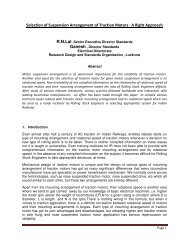

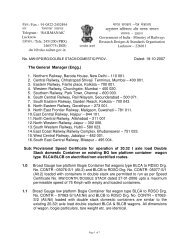
![Hkkjrljdkj] jsy ea= ky; vuql a/ kkuvfHkdYivkSj ekudlax Bu y ... - rdso](https://img.yumpu.com/21978459/1/184x260/hkkjrljdkj-jsy-ea-ky-vuql-a-kkuvfhkdyivksj-ekudlax-bu-y-rdso.jpg?quality=85)

